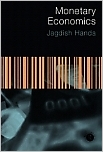| |||||
• polskie
• Zamów informacje o nowościach z wybranego tematu • kontakt |
MONETARY ECONOMICSHANDA Jwydawnictwo: ROUTLEDGE, 2000, wydanie Icena netto: This textbook breaks new ground in developing an integrated and comprehensive overview of advanced monetary economics. It achieves this by integrating the presentation of monetary theory with its heritage, empirical formulations and their empirical tests. While many texts confine themselves to coverage of the demand and supply of money, or to macroeconomic and monetary policy, Monetary Economics brings together the core areas of monetary economics in a single source. Key features include: - cross-country comparison of central banking in the USA, UK and Canada as well as in developing countries, - theories and empirical studies of money demand, including precautionary and buffer stock models and monetary aggregation, - detailed comparison of Keynesian and modern classical macroeconomic theory and policy models, - focus on the role of money and financial institutions and growth, including the contribution of endogenous growth theory to the understanding of financial institutions in the economy. Pioneering in the comprehensiveness of its coverage, Monetary Economics also contains a state-of-the-art treatment of the theory, empirical methods and findings on monetary economics. Students will in particular welcome the close integration between theories and their empirical studies. Requiring only a grounding in the principles of economics, this text is comprehensive enough to be used on a two term course, or used selectively on one term courses. Written in such a way that the theory of monetary economics is tempered by the goals of empirical relevance and intuitive understanding, the book contains the following pedagogical features: beginning of introductions and key concepts; end of chapter summaries plus review and discussion questions. Monetary Economics will be of interest to teachers and students of not only monetary economics, but money, banking and macroeconomics. Table of contents Part I: Introduction and Heritage 1. Introduction Part II: Money in the Economy 3. Money in the Economy: General Equilibrium Analysis Part III: The Demand for Money 4. The Transactions Demand
for Money Part IV: Money Supply and Central Banking 10. The Money Supply Process
Part V: Money in the Macroeconomy 13. The Classical Paradigm in Macroeconomics: Neoclassical and Classical Models 14. The Keynesian and
Neokeynesian Approaches to Short Run Macroeconomics Part VI: Money in the Open Economy 18. The Open Economy:
Exchange Rates and the Balance of Payments Part VII: The Rates of Interest in the Economy 20. The Macroeconomic Theory
of the Rate of Interest Part VIII: Overlapping Generations Models of Money 22. The Overlapping
Generations Model of Fiat Money Part IX: Money and Financial Institutions in Growth Economy 25. Neoclassical Growth
Theory Without Money 766 pages
Po otrzymaniu zamówienia poinformujemy pocztą e-mail lub telefonicznie, |


